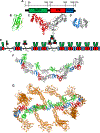The ubiquitin ligase adaptor SPOP in cancer
- PMID: 31495053
- PMCID: PMC6803047
- DOI: 10.1111/febs.15056
The ubiquitin ligase adaptor SPOP in cancer
Abstract
The dysregulation of ubiquitin-mediated proteasomal degradation has emerged as an important mechanism of pathogenesis in several cancers. The speckle-type POZ protein (SPOP) functions as a substrate adaptor for the cullin3-RING ubiquitin ligase and controls the cellular persistence of a diverse array of protein substrates in hormone signalling, epigenetic control and cell cycle regulation, to name a few. Mutations in SPOP and the resulting dysregulation of this proteostatic pathway play causative roles in the pathogenesis of prostate and endometrial cancers, whereas overexpression and mislocalization are associated with kidney cancer. Understanding the molecular mechanism of the normal function of SPOP as well as the cause of SPOP-mediated oncogenesis is thus critical for eventual therapeutic targeting of SPOP and other related pathways. Here, we will review SPOP structure, function and the molecular mechanism of how this function is achieved. We will then review how mutations and protein mislocalization contribute to cancer pathogenesis and will provide a perspective on how SPOP may be targeted therapeutically.
Keywords: SPOP; endometrial cancer; intrinsically disordered proteins; liquid-liquid phase separation; prostate cancer; ubiquitin ligase; ubiquitination.
© 2019 Federation of European Biochemical Societies.
Conflict of interest statement
Figures




Similar articles
-
Challenges and opportunities for the diverse substrates of SPOP E3 ubiquitin ligase in cancer.Theranostics. 2025 May 8;15(13):6111-6145. doi: 10.7150/thno.113356. eCollection 2025. Theranostics. 2025. PMID: 40521202 Free PMC article. Review.
-
Cancer Mutations of the Tumor Suppressor SPOP Disrupt the Formation of Active, Phase-Separated Compartments.Mol Cell. 2018 Oct 4;72(1):19-36.e8. doi: 10.1016/j.molcel.2018.08.027. Epub 2018 Sep 20. Mol Cell. 2018. PMID: 30244836 Free PMC article.
-
Reduction of oligomer size modulates the competition between cluster formation and phase separation of the tumor suppressor SPOP.J Biol Chem. 2023 Dec;299(12):105427. doi: 10.1016/j.jbc.2023.105427. Epub 2023 Nov 4. J Biol Chem. 2023. PMID: 37926283 Free PMC article.
-
The emerging role of SPOP protein in tumorigenesis and cancer therapy.Mol Cancer. 2020 Jan 4;19(1):2. doi: 10.1186/s12943-019-1124-x. Mol Cancer. 2020. PMID: 31901237 Free PMC article. Review.
-
Endometrial cancer-associated mutants of SPOP are defective in regulating estrogen receptor-α protein turnover.Cell Death Dis. 2015 Mar 12;6(3):e1687. doi: 10.1038/cddis.2015.47. Cell Death Dis. 2015. PMID: 25766326 Free PMC article.
Cited by
-
SPOP promotes cervical cancer progression by inducing the movement of PD-1 away from PD-L1 in spatial localization.J Transl Med. 2022 Aug 30;20(1):384. doi: 10.1186/s12967-022-03574-6. J Transl Med. 2022. PMID: 36042498 Free PMC article.
-
Intrinsically disordered substrates dictate SPOP subnuclear localization and ubiquitination activity.J Biol Chem. 2021 Jan-Jun;296:100693. doi: 10.1016/j.jbc.2021.100693. Epub 2021 Apr 22. J Biol Chem. 2021. PMID: 33894201 Free PMC article.
-
Interrogating bromodomain inhibitor resistance in KMT2A-rearranged leukemia through combinatorial CRISPR screens.Proc Natl Acad Sci U S A. 2023 Apr 18;120(16):e2220134120. doi: 10.1073/pnas.2220134120. Epub 2023 Apr 10. Proc Natl Acad Sci U S A. 2023. PMID: 37036970 Free PMC article.
-
SPOP-dependent destabilization of SYT12 in a GSK-3β-dependent manner in papillary thyroid cancer cells.Clin Exp Med. 2025 Jul 10;25(1):243. doi: 10.1007/s10238-025-01791-z. Clin Exp Med. 2025. PMID: 40640517 Free PMC article.
-
Speckle-type POZ protein could play a potential inhibitory role in human renal cell carcinoma.BMC Cancer. 2022 Dec 7;22(1):1277. doi: 10.1186/s12885-022-10340-w. BMC Cancer. 2022. PMID: 36474188 Free PMC article.
References
-
- Nagai Y, Kojima T, Muro Y, Hachiya T, Nishizawa Y, Wakabayashi T & Hagiwara M (1997) Identification of a novel nuclear speckle-type protein, SPOP, FEBS Lett. 418, 23–6. - PubMed
-
- Kwon JE, La M, Oh KH, Oh YM, Kim GR, Seol JH, Baek SH, Chiba T, Tanaka K, Bang OS, Joe CO & Chung CH (2006) BTB domain-containing speckle-type POZ protein (SPOP) serves as an adaptor of Daxx for ubiquitination by Cul3-based ubiquitin ligase, J Biol Chem. 281, 12664–72. - PubMed
-
- Hernandez-Munoz I, Lund AH, van der Stoop P, Boutsma E, Muijrers I, Verhoeven E, Nusinow DA, Panning B, Marahrens Y & van Lohuizen M (2005) Stable X chromosome inactivation involves the PRC1 Polycomb complex and requires histone MACROH2A1 and the CULLIN3/SPOP ubiquitin E3 ligase, Proc Natl Acad Sci U S A. 102, 7635–40. - PMC - PubMed
-
- Kent D, Bush EW & Hooper JE (2006) Roadkill attenuates Hedgehog responses through degradation of Cubitus interruptus, Development. 133, 2001–10. - PubMed
-
- Zhuang M, Calabrese MF, Liu J, Waddell MB, Nourse A, Hammel M, Miller DJ, Walden H, Duda DM, Seyedin SN, Hoggard T, Harper JW, White KP & Schulman BA (2009) Structures of SPOP-substrate complexes: insights into molecular architectures of BTB-Cul3 ubiquitin ligases, Mol Cell. 36, 39–50. - PMC - PubMed
Publication types
MeSH terms
Substances
Grants and funding
LinkOut - more resources
Full Text Sources

